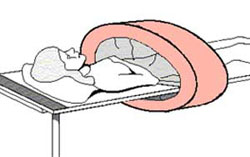Hyperthermia: Microwaves as Cancer Treatment
Hyperthermia: Microwaves as Cancer Treatment
Hyperthermia (or thermotherapy) is a cancer treatment that involves heating tumor cells within the body. Elevating the temperature of tumor cells results in cell membrane damage, which, in turn, leads to the destruction of the cancer cells. Over a hundred years ago, doctors first noticed that high heat, such as that resulting from a fever, killed cancer cells and shrank tumors. Research into hyperthermia as a cancer treatment began soon after. Today hyperthermia is used as an adjunct to radiation therapy and chemotherapy.
Hyperthermia treatment of cancer requires directing a carefully controlled dose of heat to the cancerous tumor and surrounding body tissue. Cancerous tissues can be destroyed at exposure to a temperature of about 108 °F for an hour. This high heat must be used wisely—too little heat and the cancer will not be killed. However, if too much heat misses the tumor target, the skin or other healthy tissues could be burned.
Microwave energy is very effective in heating cancerous tumors, because tumors typically have high-water content. Such tissue heats very rapidly when exposed to high-power microwaves. Furthermore, microwaves can be delivered to tissue by special-purpose antennas that are located adjacent to the patient’s body. Depending on the tumor size and location in the body, one or more microwave antennas can be used to treat the tumor. When a microwave thermotherapy antenna is turned “on,” body tissues with high-water content that are irradiated with significant amounts of microwave energy are heated. The temperature rise in the tissue is due to the transfer of microwave energy into heat. Generating heat from microwaves is very similar to the effect of ordinary mechanical friction such as warming your hands by rubbing them together. As the microwave energy (oscillating about a billion times a second) passes through the tissue, water molecules are vibrated. Frictional forces between the water molecules in the tissue result in the heating of the tissue. By concentrating the microwave energy, it is possible to selectively heat tumors and protect healthy tissues. This process of concentrating or focusing microwaves at a tumor is somewhat analogous to a group of orchestral instruments being played in synchronization—when played together, a bunch of individual instruments make a big sound. In the same way, synchronized radiating antennas produce concentrated microwaves.
In 1990, Dr. Alan J. Fenn, an electrical engineer at the Massachusetts Institute of Technology’s Lincoln Laboratory developed a concept for heating deep tumors by means of adaptive microwaves. These adjust to the properties of a patient’s tissue to concentrate the microwave energy at the tumor position. These adaptive microwaves are generated by multiple microwave antennas (an adaptive phased array) that surround the human body.
In addition to treating cancer, microwave heating is an effective treatment of an enlarged prostate gland (a common non-cancerous condition in males). A microwave-radiating device heats the prostate gland, which shrinks it. Microwaves also show promise as a diagnostic tool, where they will act as a sort of radar for your body. Research in this use of microwaves in medicine, as well as many others, continues. There is little doubt that the doctor’s office of tomorrow will make increasing use of microwaves.
